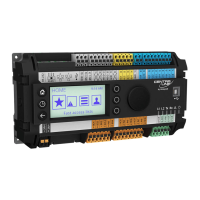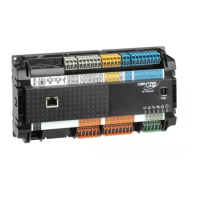EAGLEHAWK CONTROLLER – INSTALLATION & COMMISSIONING INSTRUCTIONS
EN1Z-1005GE51 R0216 24
Connecting EAGLEHAWK via its RS485-2 Interface to a Modbus
With regards to Fig. 38, please note the following:
NOTE: Always power each EAGLEHAWK controller and the connected Modbus slaves via separate transformers.
NOTE: For “L,” see section “RS485 Standard” on pg. 8.
NOTE: If any devices are not electrically isolated, signal ground connection is recommended. See section “RS485 Standard”
on pg. 8).
NOTE: Between devices equipped with non-isolated RS485 bus interfaces, potential differences of max. ±7 V are allowed.
Further, this bus should not extend beyond a single building.
Example: EAGLEHAWK Modbus Master Controller and Connected Modbus Slaves (with inserted termination
resistor)
1 2
24V~
24~0
2930 31
GND-2
GND-2+5V
RS485-2 (+) RS485-2 (-)
550 OHM 550 OHM130 OHM
F1
230 V
24 V
R
T
Modbus
Module #2
RS485 +
RS485 -
GND
Modbus
Module #3
Modbus
Module #4
Modbus
Module #N-1
Modbus
Module #N
RS485 +
RS485 +
RS485 +
RS485 +
RS485 -
RS485 -
RS485 -
RS485 -
GND
GND
GND
GND
L
Modbus
Module #1
END
BI
S
MID
NO EFFECT ON RS485-2
*CONNECT GND, IF AVAILABLE.
120 OHM
EAGLEHAWK
Fig. 38. Connection of an EAGLEHAWK Modbus master controller via its RS485-2 interface to a Modbus with slaves
The termination resistor must be inserted directly into the terminals of the last Modbus slave.
NOTE: If an EAGLEHAWK connected to a Modbus via its RS485-2 interface is itself to be used as a Modbus RTU slave,
then it must be situated in a position at the beginning or at the end of the Modbus; this is because the bias and
termination resistors of its RS485-2 interface are always ON (see Fig. 14).

